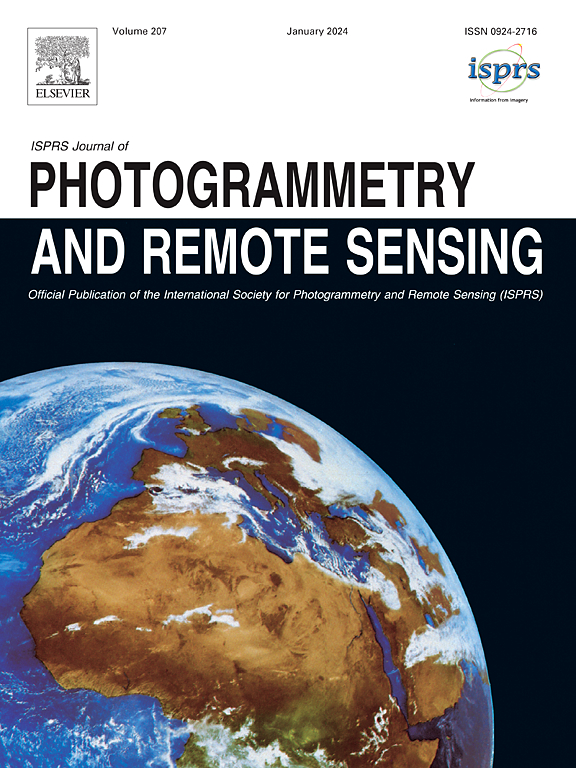A_OPTRAM-ET: An automatic optical trapezoid model for evapotranspiration estimation and its global-scale assessments
IF 10.6
1区 地球科学
Q1 GEOGRAPHY, PHYSICAL
ISPRS Journal of Photogrammetry and Remote Sensing
Pub Date : 2024-11-02
DOI:10.1016/j.isprsjprs.2024.10.019
引用次数: 0
Abstract
Remotely sensed evapotranspiration (ET) at a high spatial resolution (30 m) has wide-ranging applications in agriculture, hydrology and meteorology. The original optical trapezoid model for ET (O_OPTRAM-ET), which does not require thermal remote sensing, shows potential for high-resolution ET estimation. However, the non-automated O_OPTRAM-ET heavily depends on visual interpretation or optimization with in situ measurements, limiting its practical utility. In this study, a SpatioTemporal Aggregated Regression algorithm (STAR) is proposed to develop an automatic trapezoid model for ET (A_OPTRAM-ET), implemented within the Google Earth Engine environment, and evaluated globally at both moderate and high resolutions (500 m and 30 m, respectively). Through the integration of an aggregation algorithm across multiple dimensions to automatically determine its parameters, A_OPTRAM-ET can operate efficiently without the need for ground-based measurements as input. Evaluation against in situ ET demonstrates that the proposed A_OPTRAM-ET model effectively estimates ET across various land cover types and satellite platforms. The overall root mean square error (RMSE), mean absolute error (MAE), and correlation coefficient (CC) when compared with in situ latent heat flux (LE) measurements are 35.5 W·m−2 (41.3 W·m−2, 40.0 W·m−2, 36.1 W·m−2,), 26.3 W·m−2 (28.9 W·m−2, 28.7 W·m−2, 25.8 W·m−2,), and 0.78 (0.73, 0.70, 0.72) for Sentinel-2 (Landsat-8, Landsat-5, MOD09GA), respectively. The A_OPTRAM-ET model exhibits a stable accuracy over long time periods (approximately 10 years). When compared with other published ET datasets, ET estimated by the A_OPTRAM-ET model is better with the land cover types of cropland and shrubland. Additionally, global ET derived from the A_OPTRAM-ET model shows trends consistent with other published ET datasets over the period 2001–2020, while offering enhanced spatial details. Therefore, the proposed A_OPTRAM-ET model provides an efficient, high-resolution, and globally applicable method for ET estimation, with significant practical values for agriculture, hydrology, and related fields.
A_OPTRAM-ET:用于蒸散估计及其全球尺度评估的自动光学梯形模型
高空间分辨率(30 米)的遥感蒸散量(ET)在农业、水文和气象领域有着广泛的应用。最初的蒸散发光学梯形模型(O_OPTRAM-ET)不需要热遥感,显示了高分辨率蒸散发估算的潜力。然而,非自动化的 O_OPTRAM-ET 在很大程度上依赖于目视判读或通过现场测量进行优化,限制了其实用性。本研究提出了一种时空聚合回归算法(STAR),用于开发一个自动梯形蒸散发模型(A_OPTRAM-ET),该模型在谷歌地球引擎环境中实施,并在中分辨率和高分辨率(分别为 500 米和 30 米)下进行了全球评估。A_OPTRAM-ET 通过整合多维度的聚合算法自动确定参数,无需地面测量数据作为输入即可高效运行。根据原位蒸散发进行的评估表明,所提出的 A_OPTRAM-ET 模型能有效估算各种土地覆被类型和卫星平台的蒸散发。与原地潜热通量(LE)测量值相比,总的均方根误差(RMSE)、平均绝对误差(MAE)和相关系数(CC)分别为 35.5 W-m-2 (41.3 W-m-2、40.0 W-m-2、36.1 W-m-2)、26.3 W-m-2(28.9 W-m-2、28.7 W-m-2、25.8 W-m-2)和 0.78(0.73、0.70、0.72)。A_OPTRAM-ET 模型在长时间内(约 10 年)都表现出稳定的精度。与其他已发布的蒸散发数据集相比,A_OPTRAM-ET 模型估算的蒸散发与耕地和灌木林等土地覆被类型的关系更好。此外,A_OPTRAM-ET 模型得出的全球蒸散发在 2001-2020 年间的趋势与其他已发布的蒸散发数据集一致,同时提供了更多的空间细节。因此,建议的 A_OPTRAM-ET 模型提供了一种高效、高分辨率和全球适用的蒸散发估算方法,对农业、水文及相关领域具有重要的实用价值。
本文章由计算机程序翻译,如有差异,请以英文原文为准。
求助全文
约1分钟内获得全文
求助全文
来源期刊

ISPRS Journal of Photogrammetry and Remote Sensing
工程技术-成像科学与照相技术
CiteScore
21.00
自引率
6.30%
发文量
273
审稿时长
40 days
期刊介绍:
The ISPRS Journal of Photogrammetry and Remote Sensing (P&RS) serves as the official journal of the International Society for Photogrammetry and Remote Sensing (ISPRS). It acts as a platform for scientists and professionals worldwide who are involved in various disciplines that utilize photogrammetry, remote sensing, spatial information systems, computer vision, and related fields. The journal aims to facilitate communication and dissemination of advancements in these disciplines, while also acting as a comprehensive source of reference and archive.
P&RS endeavors to publish high-quality, peer-reviewed research papers that are preferably original and have not been published before. These papers can cover scientific/research, technological development, or application/practical aspects. Additionally, the journal welcomes papers that are based on presentations from ISPRS meetings, as long as they are considered significant contributions to the aforementioned fields.
In particular, P&RS encourages the submission of papers that are of broad scientific interest, showcase innovative applications (especially in emerging fields), have an interdisciplinary focus, discuss topics that have received limited attention in P&RS or related journals, or explore new directions in scientific or professional realms. It is preferred that theoretical papers include practical applications, while papers focusing on systems and applications should include a theoretical background.
 求助内容:
求助内容: 应助结果提醒方式:
应助结果提醒方式:


